2017 NISSAN LEAF keyless entry
[x] Cancel search: keyless entryPage 204 of 424
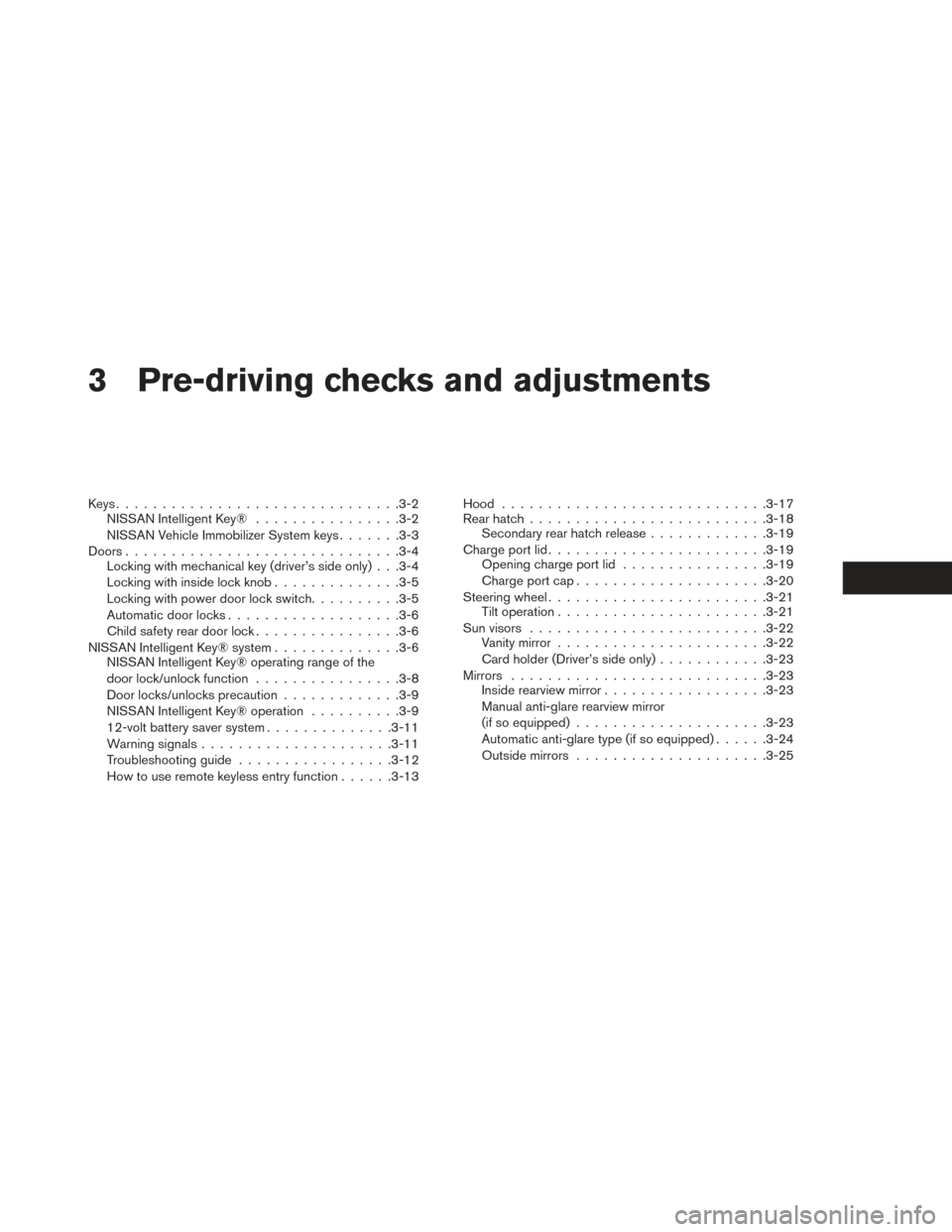
3 Pre-driving checks and adjustments
Keys...............................3-2
NISSAN Intelligent Key® ................3-2
NISSAN Vehicle Immobilizer System keys .......3-3
Doors ............................. .3-4
Locking with mechanical key (driver’s side only) . . .3-4
Locking with inside lock knob ..............3-5
Locking with power door lock switch ..........3-5
Automatic door locks .................. .3-6
Child safety rear door lock ................3-6
NISSAN Intelligent Key® system ..............3-6
NISSAN Intelligent Key® operating range of the
door lock/unlock function ................3-8
Door locks/unlocks precaution .............3-9
NISSAN Intelligent Key® operation ..........3-9
12-volt battery saver system ..............3-11
Warning signals .................... .3-11
Troubleshooting guide ................ .3-12
How to use remote keyless entry function ......3-13Hood
............................ .3-17
Rear hatch ......................... .3-18
Secondary rear hatch release .............3-19
Charge port lid ....................... .3-19
Opening charge port lid ................3-19
Charge port cap .................... .3-20
Steering wheel ....................... .3-21
Tilt operation ...................... .3-21
Sun visors ......................... .3-22
Vanity mirror ...................... .3-22
Card holder (Driver’s side only) ............3-23
Mirrors ........................... .3-23
Inside rearview mirror ................. .3-23
Manual anti-glare rearview mirror
(if so equipped) .................... .3-23
Automatic anti-glare type (if so equipped) ......3-24
Outside mirrors .................... .3-25
Page 216 of 424
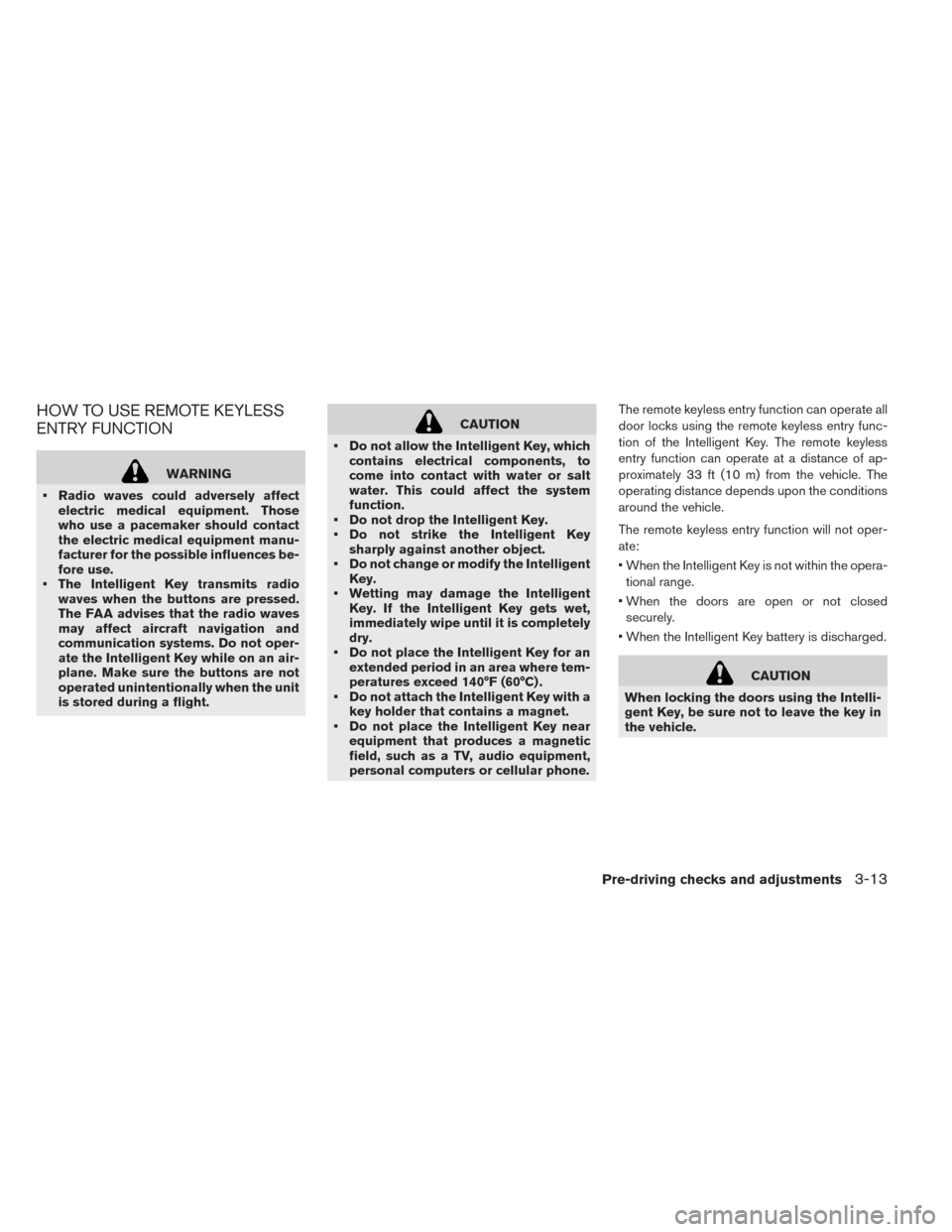
HOW TO USE REMOTE KEYLESS
ENTRY FUNCTION
WARNING
• Radio waves could adversely affect electric medical equipment. Those
who use a pacemaker should contact
the electric medical equipment manu-
facturer for the possible influences be-
fore use.
• The Intelligent Key transmits radio waves when the buttons are pressed.
The FAA advises that the radio waves
may affect aircraft navigation and
communication systems. Do not oper-
ate the Intelligent Key while on an air-
plane. Make sure the buttons are not
operated unintentionally when the unit
is stored during a flight.
CAUTION
• Do not allow the Intelligent Key, which contains electrical components, to
come into contact with water or salt
water. This could affect the system
function.
• Do not drop the Intelligent Key.
• Do not strike the Intelligent Key sharply against another object.
• Do not change or modify the Intelligent Key.
• Wetting may damage the Intelligent Key. If the Intelligent Key gets wet,
immediately wipe until it is completely
dry.
• Do not place the Intelligent Key for an extended period in an area where tem-
peratures exceed 140°F (60°C) .
• Do not attach the Intelligent Key with a key holder that contains a magnet.
• Do not place the Intelligent Key near equipment that produces a magnetic
field, such as a TV, audio equipment,
personal computers or cellular phone. The remote keyless entry function can operate all
door locks using the remote keyless entry func-
tion of the Intelligent Key. The remote keyless
entry function can operate at a distance of ap-
proximately 33 ft (10 m) from the vehicle. The
operating distance depends upon the conditions
around the vehicle.
The remote keyless entry function will not oper-
ate:
• When the Intelligent Key is not within the opera-
tional range.
• When the doors are open or not closed securely.
• When the Intelligent Key battery is discharged.
CAUTION
When locking the doors using the Intelli-
gent Key, be sure not to leave the key in
the vehicle.
Pre-driving checks and adjustments3-13
Page 332 of 424
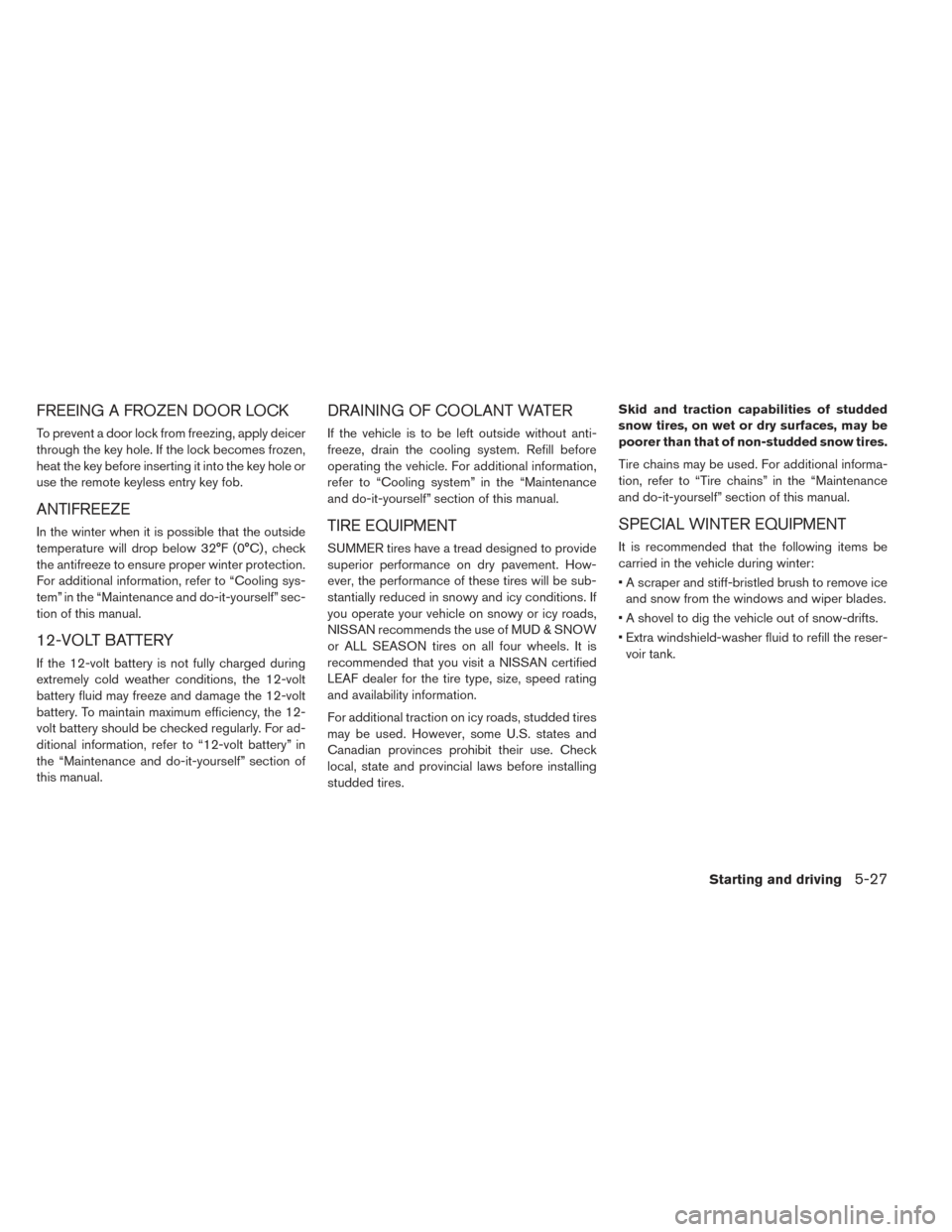
FREEING A FROZEN DOOR LOCK
To prevent a door lock from freezing, apply deicer
through the key hole. If the lock becomes frozen,
heat the key before inserting it into the key hole or
use the remote keyless entry key fob.
ANTIFREEZE
In the winter when it is possible that the outside
temperature will drop below 32°F (0°C) , check
the antifreeze to ensure proper winter protection.
For additional information, refer to “Cooling sys-
tem” in the “Maintenance and do-it-yourself” sec-
tion of this manual.
12-VOLT BATTERY
If the 12-volt battery is not fully charged during
extremely cold weather conditions, the 12-volt
battery fluid may freeze and damage the 12-volt
battery. To maintain maximum efficiency, the 12-
volt battery should be checked regularly. For ad-
ditional information, refer to “12-volt battery” in
the “Maintenance and do-it-yourself” section of
this manual.
DRAINING OF COOLANT WATER
If the vehicle is to be left outside without anti-
freeze, drain the cooling system. Refill before
operating the vehicle. For additional information,
refer to “Cooling system” in the “Maintenance
and do-it-yourself” section of this manual.
TIRE EQUIPMENT
SUMMER tires have a tread designed to provide
superior performance on dry pavement. How-
ever, the performance of these tires will be sub-
stantially reduced in snowy and icy conditions. If
you operate your vehicle on snowy or icy roads,
NISSAN recommends the use of MUD & SNOW
or ALL SEASON tires on all four wheels. It is
recommended that you visit a NISSAN certified
LEAF dealer for the tire type, size, speed rating
and availability information.
For additional traction on icy roads, studded tires
may be used. However, some U.S. states and
Canadian provinces prohibit their use. Check
local, state and provincial laws before installing
studded tires.Skid and traction capabilities of studded
snow tires, on wet or dry surfaces, may be
poorer than that of non-studded snow tires.
Tire chains may be used. For additional informa-
tion, refer to “Tire chains” in the “Maintenance
and do-it-yourself” section of this manual.
SPECIAL WINTER EQUIPMENT
It is recommended that the following items be
carried in the vehicle during winter:
• A scraper and stiff-bristled brush to remove ice
and snow from the windows and wiper blades.
• A shovel to dig the vehicle out of snow-drifts.
• Extra windshield-washer fluid to refill the reser- voir tank.
Starting and driving5-27
Page 418 of 424
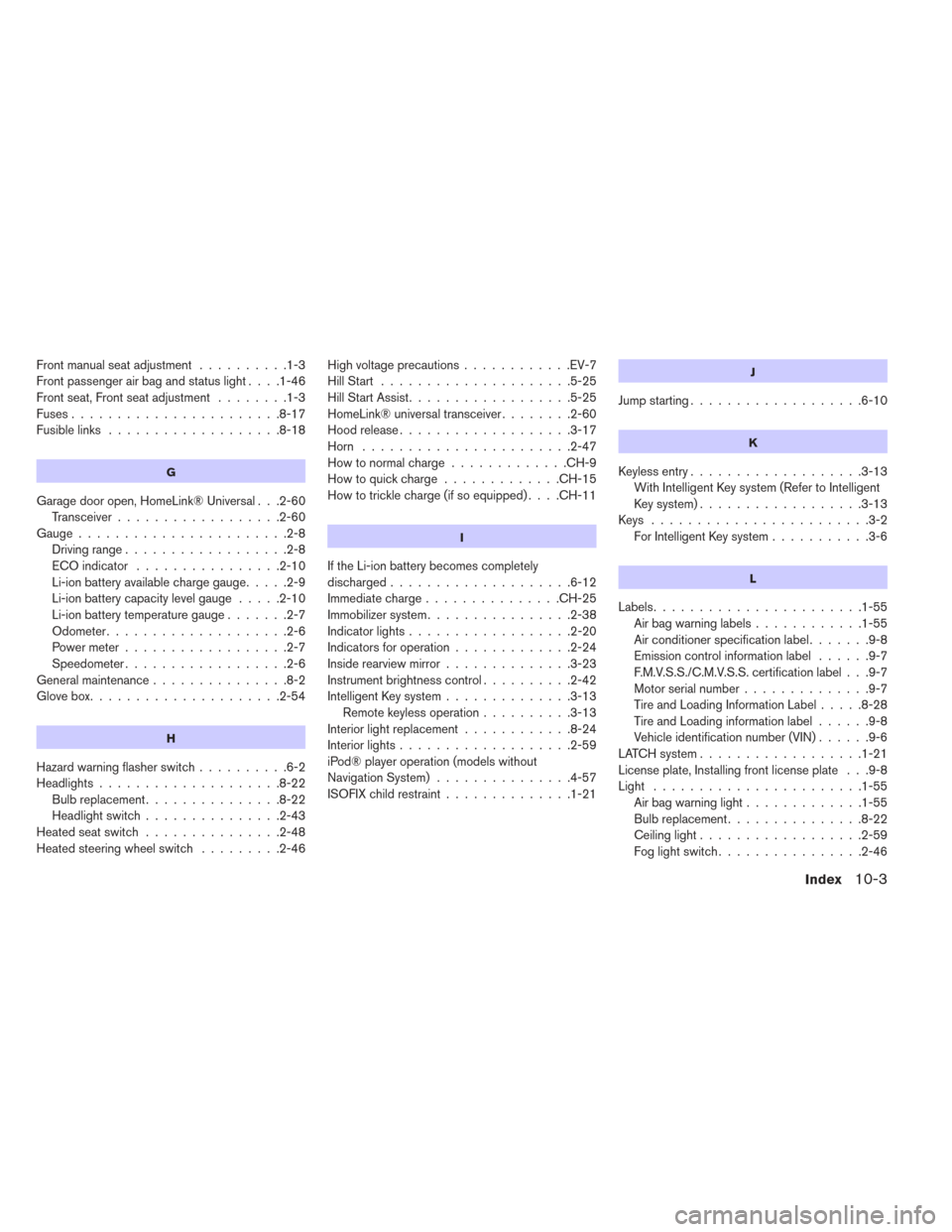
Front manual seat adjustment..........1-3
Front passenger air bag and status light ....1-46
Front seat, Front seat adjustment ........1-3
Fuses.......................8-17
Fusiblelinks ...................8-18
G
Garage door open, HomeLink® Universal . . .2-60 Transceiver ..................2-60
Gauge.......................2-8 Driving range ..................2-8
ECOindicator ................2-10
Li-ion battery available charge gauge .....2-9
Li-ion battery capacity level gauge .....2-10
Li-ion battery temperature gauge .......2-7
Odometer ....................2-6
Power meter ..................2-7
Speedometer ..................2-6
Generalmaintenance...............8-2
Glovebox.....................2-54
H
Hazard warning flasher switch ..........6-2
Headlights ....................8-22
Bulb replacement ...............8-22
Headlightswitch...............2-43
Heatedseatswitch ...............2-48
Heated steering wheel switch .........2-46Highvoltageprecautions............EV-7
HillStart .....................5-25
Hill Start Assist
..................5-25
HomeLink® universal transceiver ........2-60
Hood release ...................3-17
Horn .......................2-47
How to normal charge .............CH-9
How to quick charge .............CH-15
How to trickle charge (if so equipped) ....CH-11
I
If the Li-ion battery becomes completely
discharged....................6-12
Immediate charge ...............CH-25
Immobilizer system ................2-38
Indicatorlights..................2-20
Indicators for operation .............2-24
Inside rearview mirror ..............3-23
Instrument brightness control ..........2-42
Intelligent Key system ..............3-13
Remote keyless operation ..........3-13
Interior light replacement ............8-24
Interior lights ...................2-59
iPod® player operation (models without
Navigation System) ...............4-57
ISOFIX child restraint ..............1-21
J
Jump starting...................6-10
K
Keyless entry...................3-13
With Intelligent Key system (Refer to Intelligent
Key system) ..................3-13
Keys ........................3-2 For Intelligent Key system ...........3-6
L
Labels.......................1-55
Airbagwarninglabels............1-55
Air conditioner specification label .......9-8
Emission control information label ......9-7
F.M.V.S.S./C.M.V.S.S. certification label . . .9-7
Motor serial number ..............9-7
Tire and Loading Information Label .....8-28
Tire and Loading information label ......9-8
Vehicle identification number (VIN) ......9-6
LATCH system ..................1-21
License plate, Installing front license plate . . .9-8
Light .......................1-55 Airbagwarninglight.............1-55
Bulb replacement ...............8-22
Ceiling light ..................2-59
Fog light switch ................2-46
Index10-3
Page 420 of 424
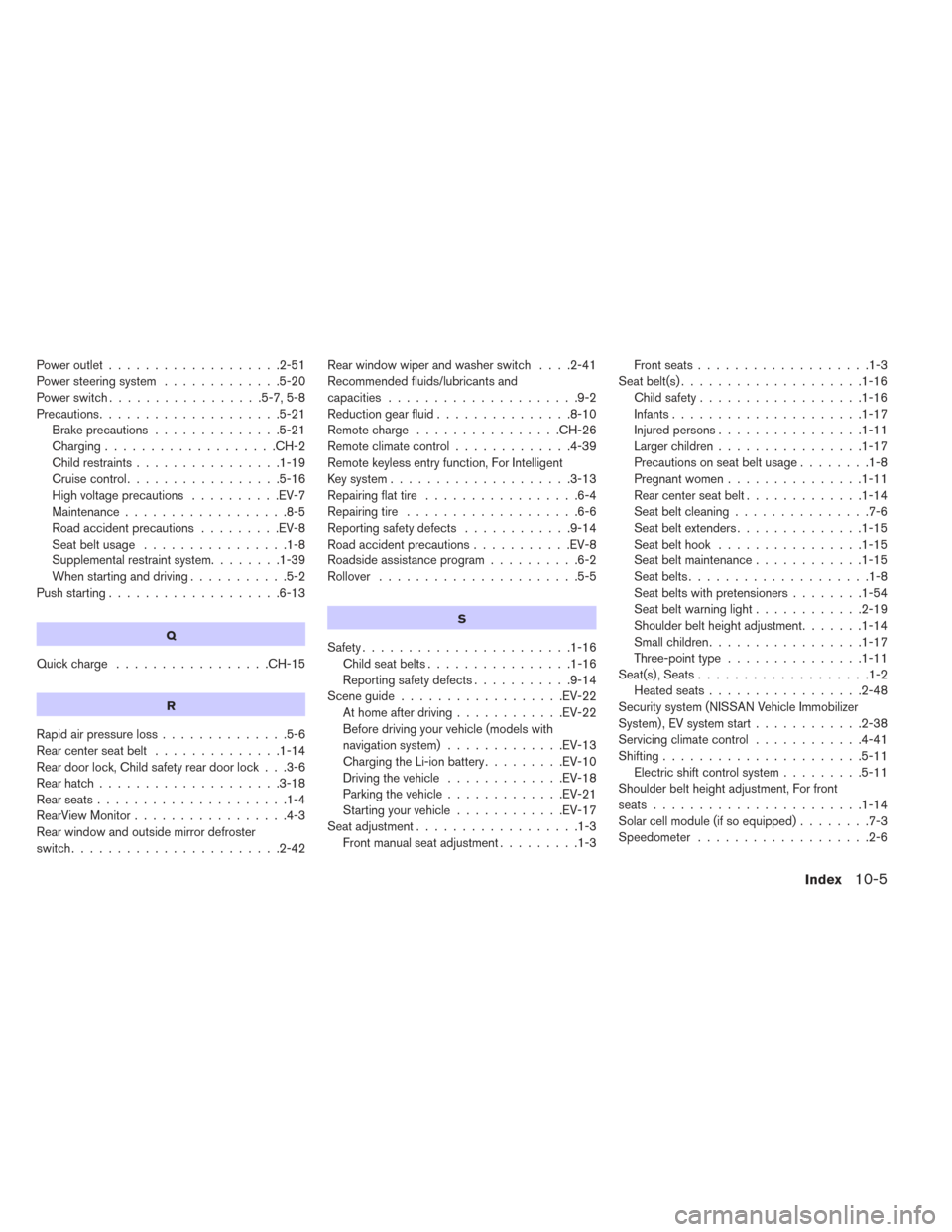
Poweroutlet...................2-51
Power steering system.............5-20
Powerswitch.................5-7,5-8
Precautions....................5-21 Brake precautions ..............5-21
Charging...................CH-2
Child restraints ................1-19
Cruisecontrol.................5-16
High voltage precautions ..........EV-7
Maintenance ..................8-5
Road accident precautions .........EV-8
Seatbeltusage ................1-8
Supplemental restraint system ........1-39
When starting and driving ...........5-2
Push starting ...................6-13
Q
Quickcharge .................CH-15
R
Rapidairpressureloss..............5-6
Rearcenterseatbelt ..............1-14
Rear door lock, Child safety rear door lock . . .3-6
Rear hatch....................3-18
Rearseats.....................1-4
RearView Monitor .................4-3
Rear window and outside mirror defroster
switch .......................2-42 Rear window wiper and washer switch
....2-41
Recommended fluids/lubricants and
capacities .....................9-2
Reduction gear fluid ...............8-10
Remote charge ................CH-26
Remote climate control .............4-39
Remote keyless entry function, For Intelligent
Key system ....................3-13
Repairing flat tire .................6-4
Repairing tire ...................6-6
Reporting safety defects ............9-14
Road accident precautions ...........EV-8
Roadside assistance program ..........6-2
Rollover ......................5-5
S
Safety.......................1-16 Childseatbelts................1-16
Reporting safety defects ...........9-14
Sceneguide..................EV-22 At home after driving ............EV-22
Before driving your vehicle (models with
navigation system) .............EV-13
Charging the Li-ion battery .........EV-10
Driving the vehicle .............EV-18
Parking the vehicle .............EV-21
Starting your vehicle ............EV-17
Seat adjustment ..................1-3
Front manual seat adjustment .........1-3Front seats
...................1-3
Seat belt(s) ....................1-16
Child safety ..................1-16
Infants.....................1-17
Injured persons ................1-11
Larger children ................1-17
Precautions on seat belt usage ........1-8
Pregnant women ...............1-11
Rearcenterseatbelt.............1-14
Seat belt cleaning ...............7-6
Seat belt extenders ..............1-15
Seat belt hook ................1-15
Seat belt maintenance ............1-15
Seatbelts....................1-8
Seatbeltswithpretensioners........1-54
Seatbeltwarninglight............2-19
Shoulder belt height adjustment .......1-14
Small children .................1-17
Three-pointtype...............1-11
Seat(s) , Seats ...................1-2
Heatedseats.................2-48
Security system (NISSAN Vehicle Immobilizer
System) , EV system start ............2-38
Servicing climate control ............4-41
Shifting ......................5-11
Electric shift control system .........5-11
Shoulder belt height adjustment, For front
seats .......................1-14
Solar cell module (if so equipped) ........7-3
Speedometer ...................2-6
Index10-5